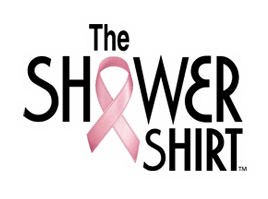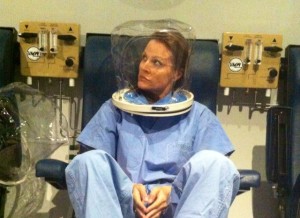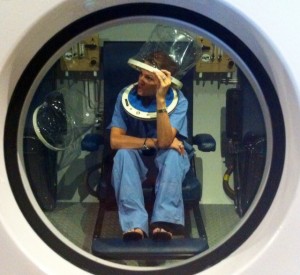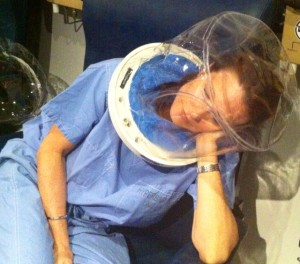Blog
The Final Prototype & My Unspoken Faith
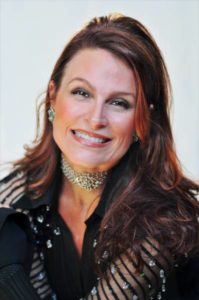 I tested the new Shower Shirt prototype multiple times and it worked tremendously. After five variations, our final design was complete and ready to be introduced to the mastectomy garment market. That is, once we were able to obtain either a category determination of a registration or approval requirement from the FDA scientist group.
I tested the new Shower Shirt prototype multiple times and it worked tremendously. After five variations, our final design was complete and ready to be introduced to the mastectomy garment market. That is, once we were able to obtain either a category determination of a registration or approval requirement from the FDA scientist group.
I wanted to be ambivalent towards this product. With all of the stress, emotion, financial constraints, surgical drains, tears and infections behind creating it, I expected to view it as a huge battle scar. Surprisingly, I couldn’t. I loved this little inanimate garment. Seeing I had never actually had children, it became my child. I felt I needed to introduce it as my own, with every bit of love that a mother has for her creation. Sounds weird, huh? Well it’s just as weird writing those words, but it was how I felt; and still do to some degree.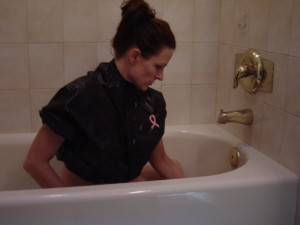
Since I was nearing my final surgery, and the Shower Shirt prototype was completed, I felt I was approaching some type of crossroad towards completion of this process. At the same time, I was also beginning another unknown journey. I knew bringing this product to market was going to change my life, my focus, and my career; for better or for worse. The product could become a joke in the mastectomy garment industry as it’s many times easier for individuals to become negative about ‘new and unfamiliar’ versus positively inspired by a new option.
I began reflecting. I had learned a multitude of lessons over the past year. Lessons I never really wanted to learn, but nevertheless, experiences which were seemingly more and more valuable as time went on. It’s ironic how various details become a blur while undergoing trauma, though many instances are as clear as yesterday. As I write this Blog, I remember the way the hyperbaric chamber smelled, phantom breast pains, and the caring voice of my significant other, Phil, asking me if I was “sad” or “happy” on any given day. I can still remember the anxiety I had before each and every surgery. When I was feeling positive, I was scared. When I was pissed off, I really didn’t care if I woke up.
I had basically survived over the past year by throwing myself into my cathartic Shower Shirt world. I missed my previous life, my freedom which came with being healthy, and of course my Mother, each and every day. I continued to lean on my faith as I was taught all things happen for a reason. I was a member of the Methodist Church and had always held my faith close, but never discussed my very simple spiritual beliefs. When diagnosed with breast cancer, my faith became a form of blind faith as I had to believe all would be OK. I have absolutely come to believe blind faith placed me in a vehicle to create the Shower Shirt product, but it was a power much higher than I who actually drove this long complicated process. Even though the Shower Shirt was my child, it was not created for me. It was created for my friends, my family members, your friends, your family members, and the hundreds of thousands of women who haven’t even been diagnosed with breast cancer as of yet.
With that mission in mind, I had to stay focused and keep marching forward. I had to get through this next surgery, become healthy again, and introduce this product to the market. My four month countdown had begun.
Stay Tuned,
Lisa F. Crites
The Shower Shirt Founder/Inventor
Health/Medical Print Journalist & Guest Columnist
Juggling Responsibilities & More Government Bureaucracy
 It was May 2010; nearly a year after hearing that infamous statement, “You have breast cancer.” Those words were the predecessor of much emotion, surgeries, infections, the Shower Shirt project, and daily hyperbaric oxygen treatments; therefore, the diagnosis was never far from my mind.
It was May 2010; nearly a year after hearing that infamous statement, “You have breast cancer.” Those words were the predecessor of much emotion, surgeries, infections, the Shower Shirt project, and daily hyperbaric oxygen treatments; therefore, the diagnosis was never far from my mind.
Day in and day out I continued to undergo hyperbaric treatments to keep the infection at bay, and a prophylactic measure to prepare for my next surgery. I was still working part-time, but nearly impossible with half of my day under an oxygen helmet with patients who had also endured wound and infection issues. Though somewhat cathartic, I had spent so much time at the treatment center I had made several friends, including multiple patients who had also acquired breast cancer surgery infections. I had initially believed my situation was somewhat unique, but quickly learned my story was one of many variation of experiences with complications related to breast cancer reconstruction.
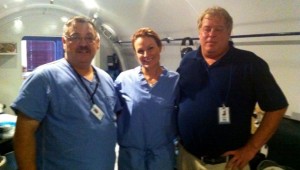 Hyperbaric Chamber Tender, Tom, & Safety Manager, James
Hyperbaric Chamber Tender, Tom, & Safety Manager, James
I was juggling a myriad of responsibilities. Along with the daily treatments, I was creating Shower Shirt marketing paraphernalia; working on applications to attain Medicare coverage; re-designing prototype options; while also paying my patent attorney huge sums of money to handle the patent application process. I then discovered I would need the Food and Drug Administration (FDA) to categorize the Shower Shirt product! The appropriate category would determine whether the product only need be registered by the FDA, or required to go through a complicated and official federal FDA approval process.
The FDA? Really? I didn’t want to deal with the government any more than I had too. The Medicare process was already stressful enough. Subsequently, I reached out to an organization in Chicago, the Anson Group, to help navigate through this additional requirement. My Chinese liaison then stated I should check into having product liability insurance. OK. Just another issue to tackle, and check to write, though not a bad idea since we live in such a litigious society.
With all of the legal, regulatory and policy interactions beginning to escalate, it sort of hit me what I had been working toward the past ten months. I was about to enter into a multi-million dollar mastectomy garment industry. The therapeutic focus behind all of this was to help women protect themselves while showering, not to enter into a complicated and highly regulated business. It was fascinating and exciting, but also scary. I had really not thought much about the global scope of bringing this product to market. For that matter, I didn’t even know this industry existed before being diagnosed with breast cancer.
Our goal was still to have the product on the market by October 2010 (Breast Cancer Awareness Month), which was just five months away. I knew there were still major hurdles and a tremendous amount of work to accomplish. At this point, I had invested so much time and energy, I just had to roll with the punches and deal with whatever the processes presented.
In the meantime, I received a call from my Chinese liaison who had finally received the updated Shower Shirt prototype. I was off to the shower to try my new product. I was a child with a new toy, but it was my toy.
Stay Tuned,
Lisa F. Crites
The Shower Shirt Co., Founder/Inventor
Health/Medical Print Journalist & Guest Columnist
Medicare Coverage & “Unstoppable”
 Questions such as; “Am I wasting my time?” or; “Is this entire project useless?” went over and over in my mind as I was anticipating finalizing the Shower Shirt product. What if no one else cared about having to shower in a trash bag after amputation of the breasts? My friends and family have (on occasion) stated I am bit high-maintenance, so did the trash bag equation simply verify my needing to be high-maintenance on occasion?
Questions such as; “Am I wasting my time?” or; “Is this entire project useless?” went over and over in my mind as I was anticipating finalizing the Shower Shirt product. What if no one else cared about having to shower in a trash bag after amputation of the breasts? My friends and family have (on occasion) stated I am bit high-maintenance, so did the trash bag equation simply verify my needing to be high-maintenance on occasion?
The bottom line was this, it didn’t really matter what I thought or felt about showering in a trash bag. What really mattered was what the masses thought. As my patent attorney kept reminding me, the most important question was: Does the product have marketability? I’m sure a familiar question thousands of inventers have asked themselves.
With that said, I was still waiting on the updated prototype to arrive; but had been notified the shipment was in route to the United States. I had recently submitted the provisional patent application for patent pending status, and now researching steps to attain Medicare coverage; a journey I knew was going to be an extremely difficult and drawn-out process, but something which had to be attained for both the Medicare patient population and commercially insured patients. Even the initial stage of the process was absolutely mind-boggling. I had on occasion heard the term “the bureaucrats in Washington,” but never really understood the terminology. Needless to say, I quickly learned what that comment meant and will expand on the Washington D.C. chain of events at a later date.
I knew a similar item; the mastectomy camisole had Medicare coverage. I began researching the Medicare coding associated with that product. In essence, the camisole was a garment to be used right after surgery to host the post-surgical drains; a tank top of sorts with a cotton prosthesis to give the appearance of breasts, and internal support pockets. Since it was used to support the drains, as the Shower Shirt product would be, I felt we might be able to also slide a similar prosthesis into the shirt, so as to attain the same Healthcare Common Procedure Coding System (HCPCS); a long shot, but a strategic one to quickly attain Medicare coverage.
On a personal note, I was still undergoing daily hyperbaric oxygen treatments. The clinicians had removed the PICC line, so no more ‘last resort’ antibiotics were being pumped into my body. I was keeping both fingers and toes crossed the hyperbaric treatments would keep the Staph infection at bay. In between the daily hyperbaric treatments, afternoon naps, and putting my toes in the water of government regulatory codes and laws, I began reading a book titled “Unstoppable,” by Cynthia Kersey. The book detailed multiple entrepreneurial ventures throughout history. The stories were powerful based on notable organizations such as Domino’s Pizza, Bill Gates and Microsoft, Walt Disney, and of course Sam Walton. However, the most powerful message which stuck in my mind was not about the hardships of these extremely successful companies. The simple message resonating with me was, “It’s harder to bring an individual product to market which has never existed, versus a product which already exists, but is changed or upgraded slightly and remarketed.”
Hmmm? A product which never existed? The SHOWER SHIRT™ absolutely fell into the category of ‘never existing’. I had thought it “cool” to have created a product which never existed; needless to say, this new revelation scared the heck out of me.
Stay Tuned,
Lisa F. Crites
The Shower Shirt Co., Founder/Inventor
Health/Medical Print Journalist & Guest Columnist
‘Last Resort’ Concerns & Daily Hyperbaric Treatments
 After a couple of weeks of morning and evening visits with my home health nurse, she felt comfortable enough to let Phil and I administer the Vancomyacin into my PICC line each evening. With only a week left before the line was scheduled to be removed, I was feeling extremely anxious. Remember, the strategy of having the PICC line was so the Vancomyacin medication (the last resort antibiotic) could treat this second Staph infection. If the drug of last resort couldn’t do the job, what was next? Was I going to be required to go through another surgery to remove an infected tissue expander? Was this the stage of the process where I needed to accept I would only have one breast the rest of my life? A myriad of questions and concerns were constantly going through my mind, along with the expectation of Dr. Z scolding me again for being an infected/complicated patient.
After a couple of weeks of morning and evening visits with my home health nurse, she felt comfortable enough to let Phil and I administer the Vancomyacin into my PICC line each evening. With only a week left before the line was scheduled to be removed, I was feeling extremely anxious. Remember, the strategy of having the PICC line was so the Vancomyacin medication (the last resort antibiotic) could treat this second Staph infection. If the drug of last resort couldn’t do the job, what was next? Was I going to be required to go through another surgery to remove an infected tissue expander? Was this the stage of the process where I needed to accept I would only have one breast the rest of my life? A myriad of questions and concerns were constantly going through my mind, along with the expectation of Dr. Z scolding me again for being an infected/complicated patient.
Coincidentally, I was having comparable issues keeping the PICC line dry (while showering) as I had with the post-mastectomy drains after surgery. With this, I realized the shower shirt sleeves were going to need to be extended to better protect PICC line patients. More importantly, I began wondering what other types of surgery patients could utilize the shower shirt. Had I missed the fact that many other surgery populations have surgical paraphernalia which need to be protected while showering as well?
It had been two months since forwarding our updates to the manufacturer. We were still waiting for the updated prototype to finalize sizing, manufacturing codes and product numbers. I was also in constant contact with the attorney I had retained for patent purposes. Based on his extensive research, there were no patents in place comparable to The SHOWER SHIRT™ garment, so he recommended filing a provisional patent application to protect us against anyone wanting to duplicate, or essentially “knock-off” the product after being introduced to the market. It was February, 2010; we were hoping to have it in on the shelves by the following October. With that goal in mind, it was none too soon to have the provisional application in place so the product would have a patent pending status before going on the market . I would then have a year to actually figure out the marketability so as to move forward with a final patent application. If the product failed miserably, I would cut my losses and not file a final patent application. But that was not going to happen, correct? This product was needed for mastectomy patients, thus, it would be a success. Or on second thought, was this entire project all about my emotions and the need to focus on something besides my ongoing breast cancer surgery complications? Questions I pondered on a daily basis, specifically, during my hyperbaric ritual each morning.
Stay Tuned,
Lisa F. Crites
The Shower Shirt Co., Founder/Inventor
Health/Medical Print Journalist & Guest Columnist
Hyperbaric Oxygen Therapy?
 In between my three weeks of sleeping and appointments each morning and evening with the home health nurse, I read an article on hyperbaric medicine, otherwise known as Hyperbaric Oxygen Therapy (HBOT), and how it was advantageous for various forms of wound healing. I forwarded the article to Dr. Z and asked if this might be an option since I had endured two severe staph infections. Based on data in the article, breast surgery patients had sought hyperbaric medicine for comparable infections and the therapy had worked tremendously.
In between my three weeks of sleeping and appointments each morning and evening with the home health nurse, I read an article on hyperbaric medicine, otherwise known as Hyperbaric Oxygen Therapy (HBOT), and how it was advantageous for various forms of wound healing. I forwarded the article to Dr. Z and asked if this might be an option since I had endured two severe staph infections. Based on data in the article, breast surgery patients had sought hyperbaric medicine for comparable infections and the therapy had worked tremendously.
Though in contrast, Dr. Z stated hyperbaric medicine was “gooble-dee-gosh.” Hmmm? ‘Gooble-dee-gosh,’ a term I had actually never heard; though possibly slang he had learned in medical school, so I looked it up. Interestingly enough, Webster’s was not familiar with the verbiage either. 🙂 Since Dr. Z had quickly put the kibosh on my thoughts to have hyperbaric medicine in conjunction with my 24-7 Vancomyacin strategy, I decided to reach out to my friend, Dr. Emran Imami, for help.
Dr. Imami and I worked together over the years when working as a broadcast journalist and had interviewed him for various stories on many clinical topics. I knew he had recently become the Medical Director for a local hyperbaric treatment center so I asked if he thought I might be a candidate for HBOT based on my medical history. In his succinct and caring voice, he said “I believe so.” I quickly met with him, and after reviewing my medical records, he said I would in fact be a good candidate to receive this type of therapy. Ultimately, our hope was to get this infection under control to keep the breast tissue expander intact to ultimately rebuild the problematic left breast.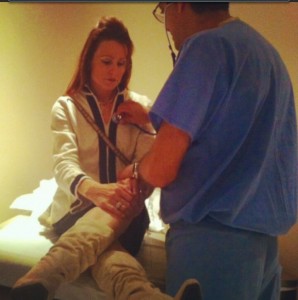 Dr. Imami checking my vitals before HBOT
Dr. Imami checking my vitals before HBOT
For the next four months, my schedule went like this. I was at the hyperbaric treatment center each morning at 7 am. I had my vital signs checked before treatment (ie: blood pressure, pulse, heart rate, temperature), changed into sterile scrubs, and required to take off all jewelry. In addition, I could not take writing utensils into the chamber since ink pens would explode under the pressure. In essence, I sat in the dive chamber with an oxygen helmet which extended below the collarbone with plastic tubing inserted into the side of the helmet, breathing 100% oxygen for three and a half hours each day. Luckily, I figured out a way to torque my body so I could sleep across two chairs on occasion.
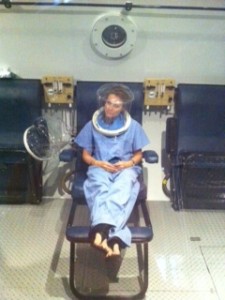 In the ‘dive chamber’ during HBOT
In the ‘dive chamber’ during HBOT
I was in the dive tank from 8 am until 11: 30 am each morning. After treatment, I exited the chamber, changed clothes and required to have another vital sign check to make sure the ‘dive’ didn’t cause abnormal stress to my body. For the first few weeks, I had the post-surgical drains in place, so quite a cumbersome process. I had some of the expected side effects of headaches, sinus issues and fatigue, otherwise my body acclimated to the process quite well. I basically woke up each morning to go to my hyperbaric therapy, slept during treatment, went back home to sleep the entire afternoon. I felt as if I had been literally cut off from the world, or in contrast, maybe I had cut myself off from the world.
For more information on hyperbaric medicine: http://www.mayoclinic.com/health/hyperbaric-oxygen-therapy/my00829
Stay Tuned,
Lisa F. Crites
The Shower Shirt Co., Founder/Inventor
Health/Medical Print Journalist & Guest Columnist
Back In The Hospital Again
 Again, a redundant, but familiar visual: I was being rolled on a hospital stretcher through Wuesthoff Medical Center Melbourne, in the process of being re-admitted to the hospital. My cell phone rings. As expected, it was Dr. Z stating; “Lisa, just because your white blood count is high, doesn’t mean you have another infection.” This time, I didn’t argue, or even drop the “f” bomb; I just hung up on him.
Again, a redundant, but familiar visual: I was being rolled on a hospital stretcher through Wuesthoff Medical Center Melbourne, in the process of being re-admitted to the hospital. My cell phone rings. As expected, it was Dr. Z stating; “Lisa, just because your white blood count is high, doesn’t mean you have another infection.” This time, I didn’t argue, or even drop the “f” bomb; I just hung up on him.
During the next several days, I dealt with Dr. Catena, my infectious disease physician. He ordered a ‘PICC line’ be placed to administer a very strong antibiotic called Vancomycin. This antibiotic traditionally has been reserved as a drug of ‘last resort’ and used only after many other antibiotics have failed. Vancomyacin can scar veins, so if the course of treatment is extended for a lengthy period of time, it is administered through a PICC line. The PICC line was to be placed the following week, but was told I could go home and return for the procedure. With that said, I was now going to have an IV stand connected to my PICC line administering this extremely strong antibiotic 24 hours per day, for the next few weeks.
It was Friday afternoon and I had been in the hospital for three days. I was expected to be discharged. However, the nurse came in and said the social worker who was responsible for coordinating my home health care and prepare my hospital discharge, had left for the day. Thus, I was going to have to stay in the hospital for the weekend. I had been there for three days with no essential clinical care except these vein scarring antibiotics running through my body via an IV in my arm. As Phil often puts it, I “ripped her a new one”, and told her these types of mistakes were exactly why the hospital had such poor patient satisfaction scores. I then called my friend George Fayer, the company’s CFO, for help.
To make a long story short, he facilitated my discharge from the hospital that evening, and arranged to have the home health nurse at my home over the weekend.
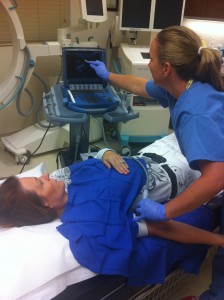
I was scheduled to have the PICC line inserted the following Monday morning. I really had no idea what to expect; I only knew this was the only option to administer this very strong antibiotic into my body to manage the infection. What I can tell you now is that it was not a comfortable procedure; I was wide awake and quite anxious as they put a tube into my arm and targeted (internally) towards my heart. I felt a very strong, warm sensation, which made me more frightened, thus more anxious, I became nauseous and broke out into a cold sweat.
After this procedure, I said to myself whatever was going to happen would happen. Whether I would only have one breast the rest of my life, or even if they could get the infection under control, I just did not have the strength to care any longer. I slept for the next three weeks, and only awoke to see the home health nurse each morning and evening. I’m not sure if I even showered, brushed my teeth and/or combed my hair during entire time. At least I was home.
According to WEB MD: A PICC line is short for Peripherally Inserted Central Catheter. Inserted through a peripheral vein in the upper arm, clinicians push the tube until the tip of the catheter reaches a large vein above the heart to administrator medications.
Stay Tuned,
Lisa F. Crites
The Shower Shirt Co., Founder/Inventor
Health/Medical Print Journalist & Guest Columnist
